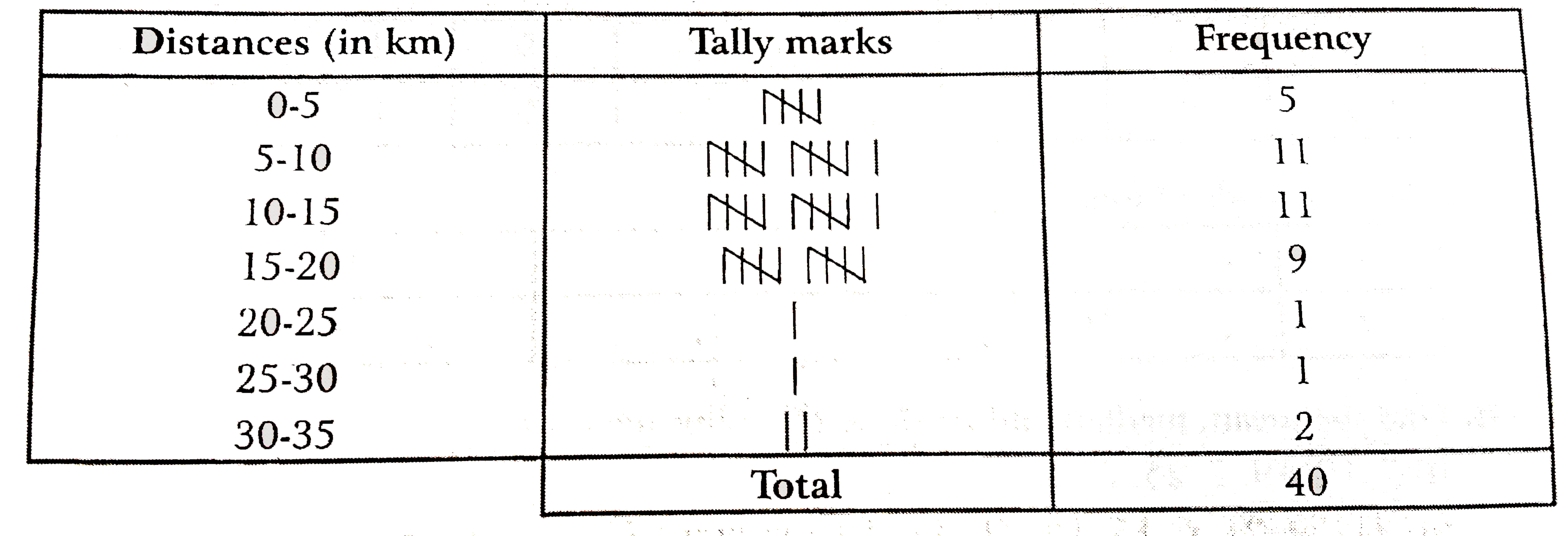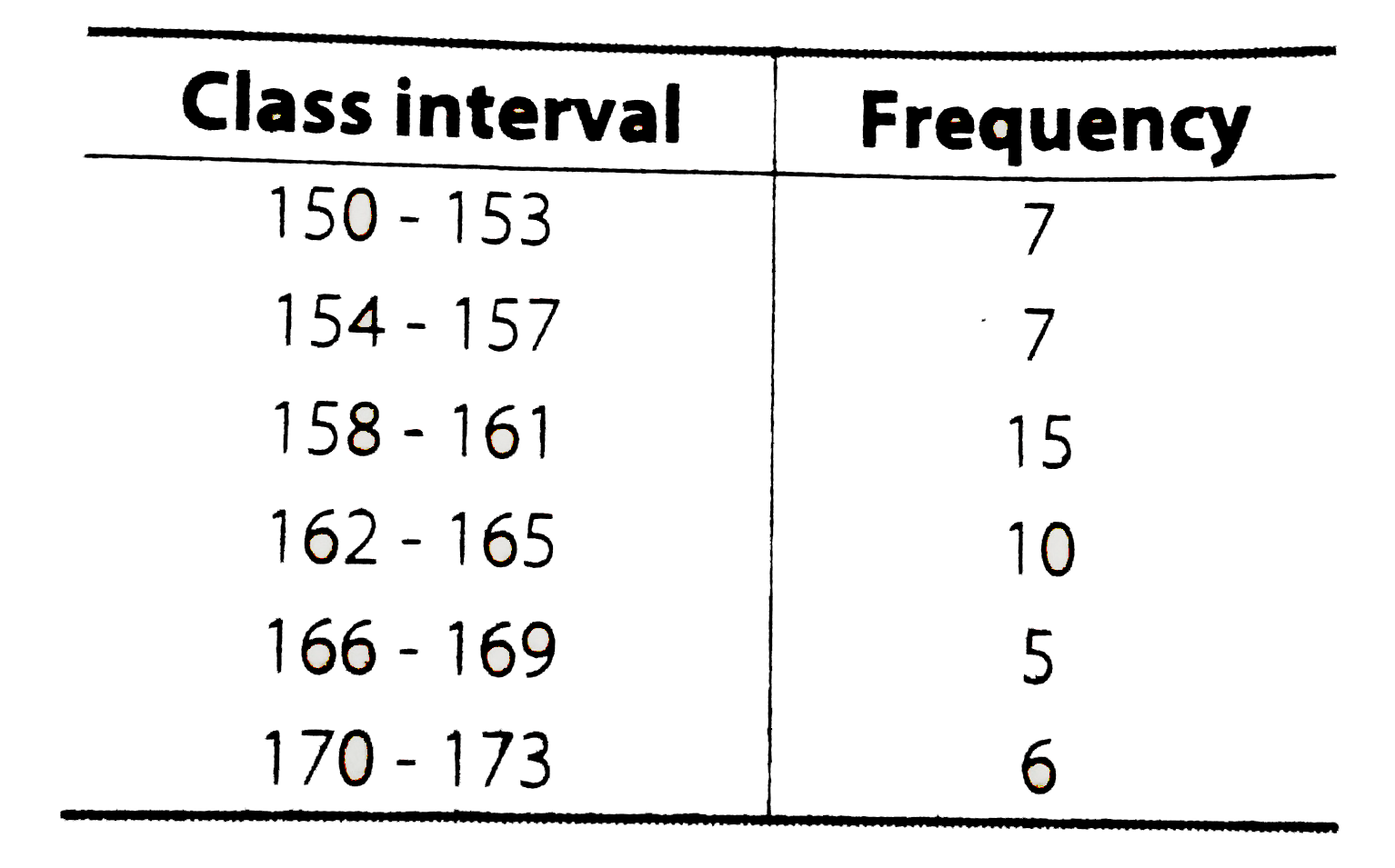The distance (in km) of 40 engineers from their residence to their place of work were found as follows.

Construct a grouped frequency distribution table with calss- size 5 for the data given above taking the first interval as 0-5 (5 not included).
To present such a large amount of data, so that a reader can make sense of it easily, we condense it into groups like, 0-5, 5-10 …., 30-35 (since, our data is from 5 to 32). These grouping are called 'classes' or 'class-intervals' and their size is called the class-size or class width which is 5 in this case. In each of these classes, the least number is called the lower class limit and the greatest number is called the upper class limit. e.g., 0-5, 0 is the 'lower class limit' and 5 is the 'upper class limit'.
Now, using tally marks, the data (given) can be condensed in tabular form as follows:

Presenting data in this form simplifies and condenses data and enables us to observe certain important feature at a glance. This is called a grouped frequency distribution table. We observe that the classes in the table above are non-overlapping.
Topper's Solved these Questions
- BOOK - NAGEEN PRAKASHAN ENGLISHCHAPTER - STATISTICSEXERCISE - Exercise 14a10videos
STATISTICS
- BOOK - NAGEEN PRAKASHAN ENGLISHCHAPTER - STATISTICSEXERCISE - EXERCISE 14B13videos
STATISTICS
- BOOK - NAGEEN PRAKASHAN ENGLISHCHAPTER - STATISTICSEXERCISE - Revision Exercise12videos
STATISTICS
- BOOK - NAGEEN PRAKASHAN ENGLISHCHAPTER - QUADRILATERALSEXERCISE - Revision Exercise (long Answer Questions)5videos
QUADRILATERALS
- BOOK - NAGEEN PRAKASHAN ENGLISHCHAPTER - SURFACE AREA AND VOLUMEEXERCISE - Revision Exercise (long Answer Questions)10videos
SURFACE AREA AND VOLUME
Similar Questions
The following is the distribution of weights (in kg) of 40 persons.

Construct a cumulative frequency distribution (of the less than type) table for the data above.View SolutionPrepare a continuous grouped frequency distribution from the following data

Also, find the size of class intervals.View SolutionThe distance (in km) of 40 engineers from their residence to their place of work were found as follows:5 3 10 20 25 11 13 7 12 31 19 10 12 17 18 11 32 17 16 2 7 9 7 8 3 5 12 15 18 3 12 14 2 9 6 15 15 7 6 12Construct a grouped frequency dist
View SolutionThe distances (in km) of 30 female engineers from their residence to their place of work were found as follows: 5 3 10 20 25 11 13 7 12 31 19 10 12 17 18 11 32 17 16 2 12 14 2 9 6 15 15 7 6 2 Find the probability that an engineer lives: (i) less than 7 km from her place of work? (ii) at least 7km from her place of work? (iii) within 12km from her place of work? (iv) at most 15km from her place of work?
View SolutionThe distances (in km) of 40 female engineers from their residence to their place of work were found as follows: 5 19 7 12 3 10 9 14 10 12 7 2 20 17 8 9 25 18 3 6 11 11 5 15 13 32 12 15 7 17 15 7 12 16 18 6 31 2 3 2 Find the probability that an engineer lives: (i) less than 7 km from her place of work? (ii) at least 7 km from her place of work? (iii) within 12 km from her place of work (iv) at most 15km from her place of work?
View SolutionConvert the given frequency distribution into a continuouos grouped frequency distribution.

In which intervals would 153.5 and 157.5 be included?View SolutionThe heights of 50 students, measured to the nearest centimetres have been found to be as follows:

(i) Represent the data given above by a grouped frequency distribution table, taking class intervals as 160-165, 165-170 etc.
(ii) What can you conclude about their heights from the table ?View SolutionA study was conducted to find out the concentration of sulphur dioxide in the air in parts per million (ppm) of a certain city. The data obtained for 30 days is a follows :

(i) Make a grouped frequency distribution table for this data with class-intervals as 0.00−0.04,0.04−0.08 and so on.
(ii) For how many day's was the concentration of sulphar dioxide more than 0.11 parts per million (ppm)?View SolutionA company manufactures car batteries of a particular type. The lives (in years) of 40 such batteries were recorded as follows: 2.6 3.0 3.7 3.2 2.2 4.1 3.5 4.53.5 2.3 3.2 3.4 3.8 3.2 4.6 3.72.5 4.4 3.4 3.3 2.9 3.0 4.3 2.83.5 3.2 3.9 3.2 3.2 3.1 3.7 3.44.6 3.8 3.2 2.6 3.5 4.2 2.9 3.6 Construct a grouped frequency distribution table for this data, using class intervals of size 0.5 starting from the interval 2 - 2.5.
View SolutionDraw an ogive to represent the following frequency distribution: Class-interval: 0-4 5-9 10-14 15-19 20-24 No. of students: 2 6 10 5 3
View Solution

